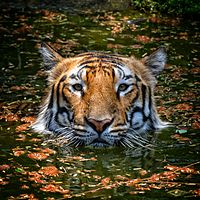
Photo from wikipedia
The purpose of this study was to evaluate the accumulation of heavy metals in the liver, skin, gills, and muscles of two freshwater edible fish species (Labeo rohita and Wallago… Click to show full abstract
The purpose of this study was to evaluate the accumulation of heavy metals in the liver, skin, gills, and muscles of two freshwater edible fish species (Labeo rohita and Wallago attu) collected from Taunsa barrage of the Indus River in Pakistan. Fish samples were collected on a seasonal basis and were analyzed by atomic absorption spectroscopy. Gills and liver accumulated relatively higher heavy metal concentrations. All fish organs accumulated the highest metal content in winter and the lowest in summer. Heavy metals accumulated in the order Fe>Zn>Ni>Cu>Pb>Cr>As in the body of Labeo rohita and the tissues with the abundance were liver>gills>skin>muscles. Similarly, the sequence of heavy metal accumulation in Wallago attu was Fe>Zn>Cu>Ni>Cr>Pb>As, and the targeted tissues were gills>liver>skin>muscles. Heavy metal bioaccumulation was different in both species. Fe was the highest and As was the least accumulated heavy metal in both of these fish species. The tissues of Wallago attu accumulated higher concentrations of Ni (83%), Cu (64%), Cr (50%), Fe (2.95%), and Zn (26%) compared to tissues of Labeo rohita. However, Pb (67%) and As (22%) accumulation in tissues of Labeo rohita were higher compared to their concentrations in tissues of Wallago attu. Overall metal burden was 10% higher in Wallago attu compared to Labeo rohita. Heavy metal concentration in fish tissues were compared with FAO threshold values.
Journal Title: Polish Journal of Environmental Studies
Year Published: 2017
Link to full text (if available)
Share on Social Media: Sign Up to like & get
recommendations!